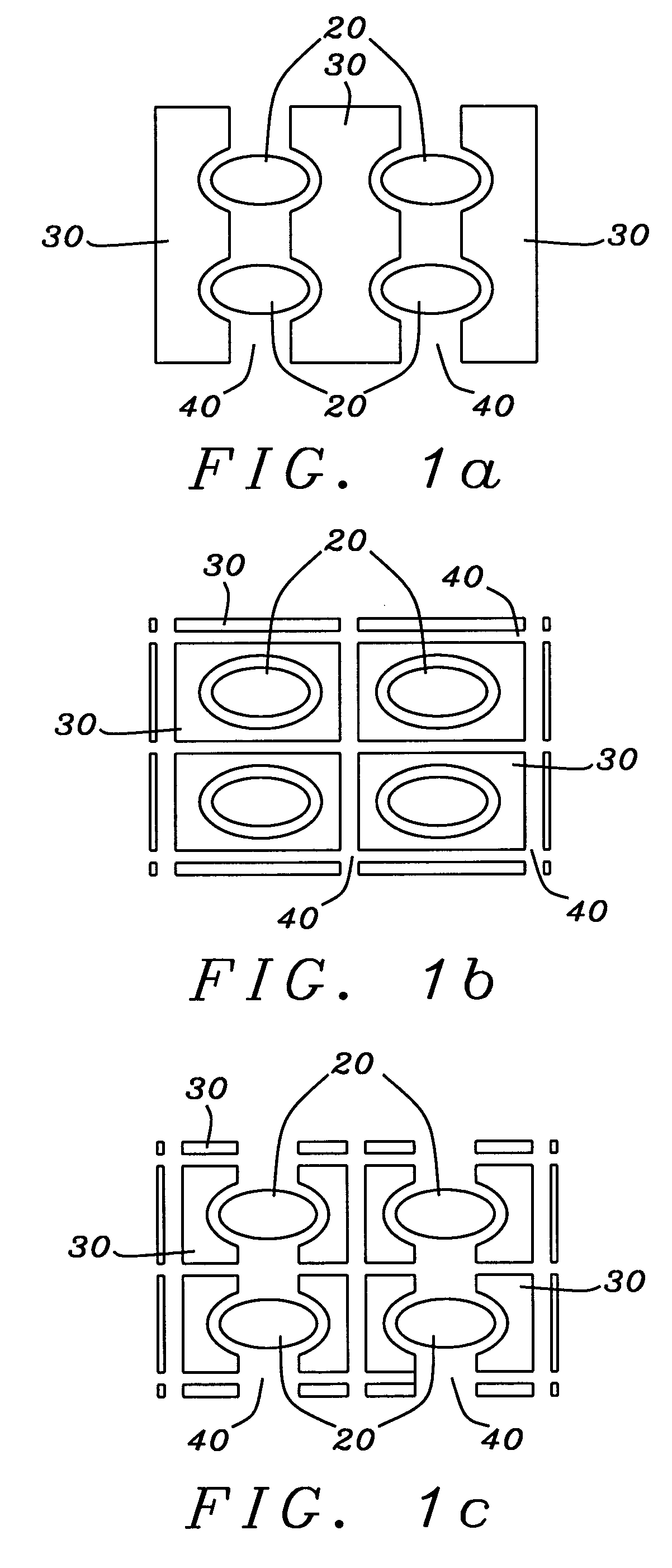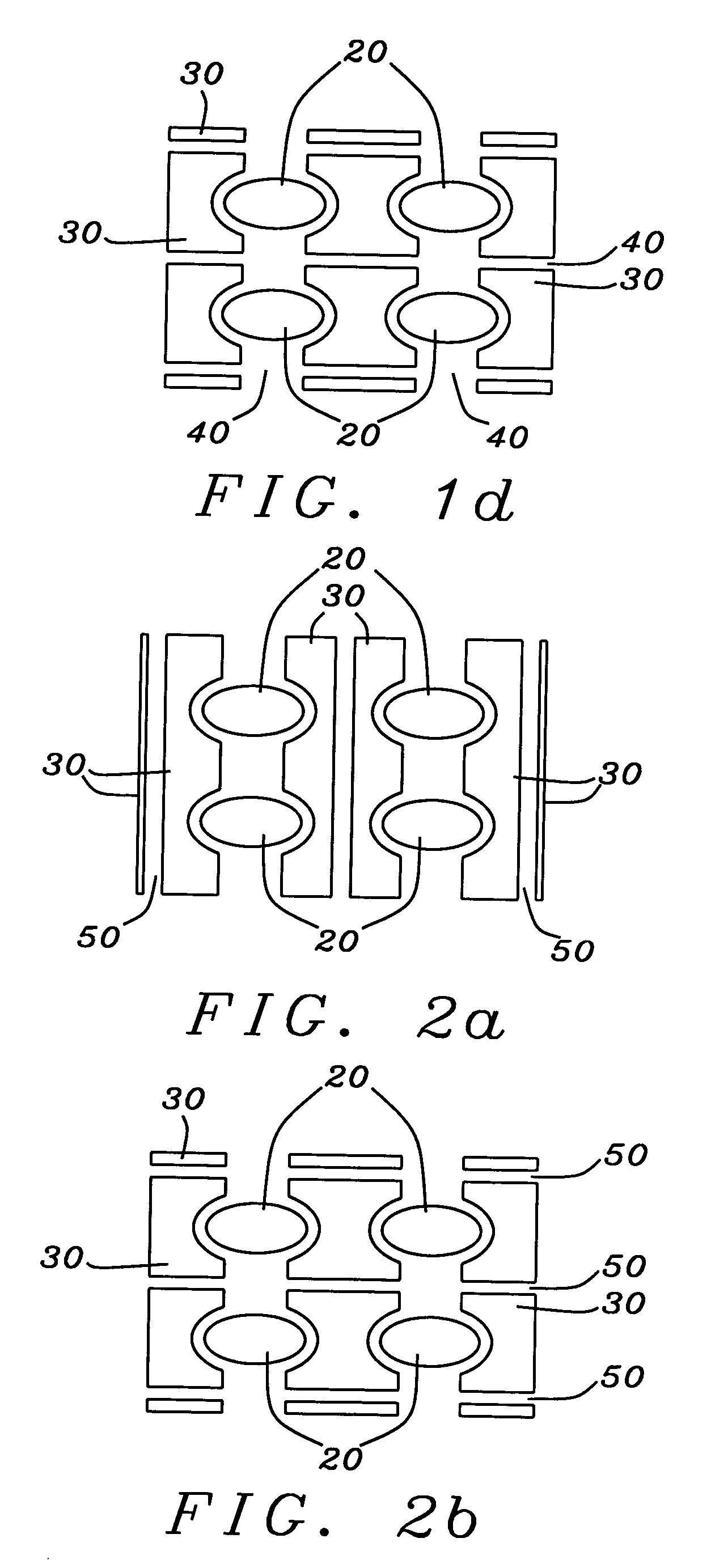[0006] In order for the MTJ MRAM device to be competitive with other forms of
DRAM, it is necessary that the MTJ be made very small, typically of sub-micron dimension. Parkin et al. (U. S. Pat. No. 6,166,948) notes that sub-micron dimensions are needed to be competitive with
DRAM memories in the range of 10-100 Mbit capacities. Parkin also notes that such small sizes are associated with significant problems, particularly super-
paramagnetism, which is the spontaneous thermal fluctuation of magnetization produced by in samples of ferromagnetic material too small to have sufficient
magnetic anisotropy (a measure of the ability of a sample to maintain a given magnetization direction). Another size-related problem results from non-uniform and uncontrollable edge-fields produced by shape-
anisotropy (a property of non-circular samples). These edge fields result in a large degree from randomly oriented magnetization vectors that form at the edges of the MTJ cells. These orientations have a tendency to curl back towards the magnetization vector of the body of the cell in an effort to minimize the
magnetic energy of the cell. Such
edge effects are also associated with uncompensated
magnetic poles that form at the cell edges. As the
cell size decreases, these edge fields become relatively more important than the magnetization of the body of the cell and have an
adverse effect on the storage and reading of data. Although such shape-anisotropies, when of sufficient magnitude, reduce the disadvantageous effects of super-paramagnetism, they have the negative effect of requiring high currents to change the magnetization direction of the MTJ for the purpose of storing data. To counteract these
edge effects, Shi et al. (U.S. Pat. No. 5,757,695) teaches the formation of an ellipsoidal MTJ cell wherein the magnetization vectors are aligned along the length (major axis) of the cell and which do not present variously oriented edge domains, high fields and poles at the ends of the element.
[0007] MTJ devices have been fabricated in several configurations, one type comprising a free ferromagnetic layer separated from a fixed (or pinned) layer. In such a configuration, the MTJ has data stored in it by causing the magnetization of its free layer to be either parallel or antiparallel to that of the pinned layer. The pinned layer may itself be a composite layer formed of two ferromagnetic layers held in an antiparallel magnetization configuration by some form of magnetic coupling so that it presents a zero or negligible net
magnetic moment to the MTJ. Such an arrangement is advantageous in reducing
edge effects due to anisotropies. Parkin, cited above, teaches an improved MTJ cell utilizing a free layer that comprises two ferromagnetic layers that are coupled by their dipolar fields in an antiparallel magnetization configuration to produce a small, but non-zero,
magnetic moment. When written on by an external applied
magnetic field, the two magnetic moments switch directions simultaneously so that the net
magnetic moment of the free layer switches direction relative to the pinned layer. In addition, Gallagher et al. (U.S. Pat. No. 5,650,958) teaches the formation of an MTJ device suitable for use in an MRAM array wherein the device comprises a free ferromagnetic layer and a pinned ferromagnetic layer which is pinned by interfacial exchange with an antiferromagnetic layer. Gallagher et al. (U.S. Pat. No. 5,841,692) also teaches the formation of an MTJ device having free and fixed layers wherein the fixed layer is formed as a sandwich of antiferromagnetically coupled ferromagnetic layers. Further, Shi et al. (U.S. Pat. No. 5,959,880) teach the formation of a low
aspect ratio MTJ device in which two layers of magnetoresistive material are separated by electrically insulating material.
[0008] It is undesirable for MTJ devices to have excessive magnetic coupling between adjacent magnetic layers of neighboring devices or even within the same device as this coupling must be overcome when writing on the device. As noted above, edge anisotropies are one source of undesirable coupling. Koch et al. (U.S. Pat. No. 6,005,800) deal with the problem that results when writing to one specific cell also affects the magnetization directions of adjacent cells that are not being addressed. Koch teaches the formation of cells with two shapes, which are mirror images of each other. The cells are arranged in a
checkerboard pattern, so that a cell of one shape is surrounded by cells of the other shape. Since neighboring cells thereby have their preferred magnetization vectors oriented differently, there is a reduced probability that writing to one
cell type will affect the magnetization of the other type.
[0009] As has been discussed, many of the problems associated with the construction of MRAM arrays are related to the shapes of the cells.
Cell shapes of present designs are typically
single element rectangle, elliptical or lozenge. Chen et al. (U.S. Pat. No. 5,917,749) provides a rectangular multi-layered MTJ cell comprising two rectangular magnetic layers magnetized in parallel directions along an easy axis corresponding to a direction of
magnetic anisotropy and separated by a non-
magnetic layer.
[0010] Any irregularities of these shapes, defects at their edges produced during their formation, or uncompensated poles of variable strength, will result in
coercivity fluctuations distributed throughout the array. It is the object of the present invention to control the problem of undesirable edge effects and non-uniform array
coercivity more effectively than is done in the prior art by providing magnetic shields between arrangements of cells within an MRAM array. These shields serve several purposes, including providing pole compensation for edge poles of cell elements, shielding cells from the effects of external magnetic fields and shielding the magnetizations of individual cells from the effects of nearby cells. The use of shields to partially surround MTJ cells is not unknown in the prior art.
Gill et al. (U.S. Pat. No. 6,219,212 B1) provide an MTJ device for use as an MRAM cell or as a
magnetic field sensor in a magnetic disk drive, in which magnetic material layers disposed above and below the MTJ device. The shields also act as current leads for the MTJ device. It is evident from the topology of the shielding layers that they are not intended to shield one such MTJ device from coplanar adjacent MTJ devices. Furthermore, it is also evident from the shield topology that they are not intended to cancel uncompensated poles formed at the edges of the magnetic free layer of the MTJ device. SUMMARY OF THE INVENTION
[0011] A first object of this invention is to provide an MRAM array of MTJ cells wherein said devices are magnetically shielded from each other and from extraneous external magnetic fields.
 Login to View More
Login to View More  Login to View More
Login to View More 


